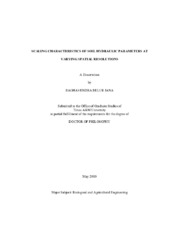| dc.contributor.advisor | Mohanty, Binayak P. | |
| dc.creator | Belur Jana, Raghavendra | |
| dc.date.accessioned | 2011-08-08T22:48:17Z | |
| dc.date.accessioned | 2011-08-09T01:27:13Z | |
| dc.date.available | 2011-08-08T22:48:17Z | |
| dc.date.available | 2011-08-09T01:27:13Z | |
| dc.date.created | 2010-05 | |
| dc.date.issued | 2011-08-08 | |
| dc.date.submitted | May 2010 | |
| dc.identifier.uri | https://hdl.handle.net/1969.1/ETD-TAMU-2010-05-8015 | |
| dc.description.abstract | This dissertation focuses on the challenge of soil hydraulic parameter scaling in soil hydrology and related applications in general; and, in particular, the upscaling of these parameters to provide effective values at coarse scales. Soil hydraulic properties are required for many hydrological and ecological models at their representative scales. Prediction accuracy of these models is highly dependent on the quality of the model input parameters. However, measurement of parameter data at all such required scales is impractical as that would entail huge outlays of finance, time and effort. Hence, alternate methods of estimating the soil hydraulic parameters at the scales of interest are necessary.
Two approaches to bridge this gap between the measurement and application scales for soil hydraulic parameters are presented in this dissertation. The first one is a stochastic approach, based on artificial neural networks (ANNs) applied within a Bayesian framework. ANNs have been used before to derive soil hydraulic parameters from other more easily measured soil properties at matching scales. Here, ANNs were applied with different training and simulation scales. This concept was further extended to work within a Bayesian framework in order to provide estimates of uncertainty in such parameter estimations. Use of ancillary information such as elevation and vegetation data, in addition to the soil physical properties, were also tested. These multiscale pedotransfer function methods were successfully tested with numerical and field studies at different locations and scales.
Most upscaling efforts thus far ignore the effect of the topography on the upscaled soil hydraulic parameter values. While this flat-terrain assumption is acceptable at coarse scales of a few hundred meters, at kilometer scales and beyond, the influence of the physical features cannot be ignored. anew upscaling scheme which accounts for variations in topography within a domain was developed to upscale soil hydraulic parameters to hill-slope (kilometer) scales. The algorithm was tested on different synthetically generated topographic configurations with good results. Extending the methodology to field conditions with greater complexities also produced good results. A comparison of different recently developed scaling schemes showed that at hill-slope scales, inclusion of topographic information produced better estimates of effective soil hydraulic parameters at that scale. | en |
| dc.format.mimetype | application/pdf | |
| dc.language.iso | en_US | |
| dc.subject | Soil hydraulic parameters | en |
| dc.subject | spatial scaling | en |
| dc.subject | scale | en |
| dc.subject | vadose zone | en |
| dc.subject | Bayesian neural networks | en |
| dc.subject | topography | en |
| dc.subject | remote sensing | en |
| dc.title | Scaling Characteristics of Soil Hydraulic Parameters at Varying Spatial Resolutions | en |
| dc.type | Thesis | en |
| thesis.degree.department | Biological and Agricultural Engineering | en |
| thesis.degree.discipline | Biological and Agricultural Engineering | en |
| thesis.degree.grantor | Texas A&M University | en |
| thesis.degree.name | Doctor of Philosophy | en |
| thesis.degree.level | Doctoral | en |
| dc.contributor.committeeMember | Efendiev, Yalchin | |
| dc.contributor.committeeMember | Smith, Patricia K. | |
| dc.contributor.committeeMember | Datta-Gupta, Akhil | |
| dc.type.genre | thesis | en |
| dc.type.material | text | en |


